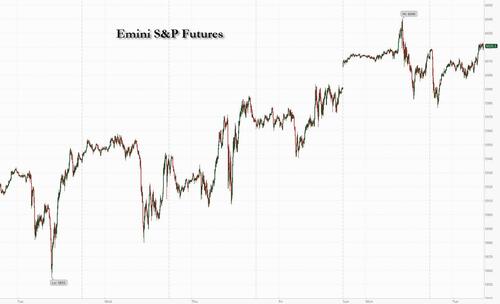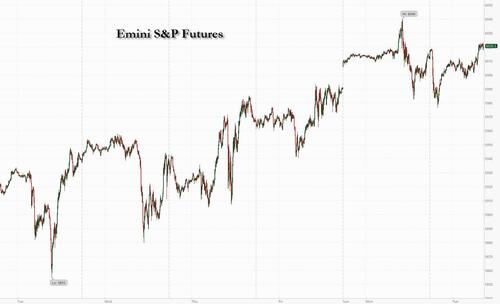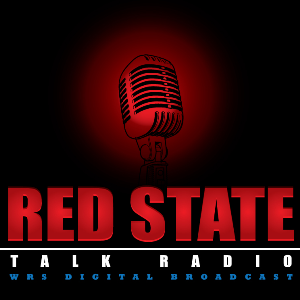Futures Rebound To Trade At Session Highs After Trump Vows New Tariffs
In a rollercoaster session of reversals, US equity futures at first slumped only to rise to session highs, while the dollar initially spiked only to slide after Donald Trump vowed to place 10% tariffs on goods from China and 25% on all imports from Mexico and Canada, a move which at first spooked the market but was subsequently viewed as “not as bad as some had expected.” As of 8:00am, S&P 500 futures were higher by 0.2%, while Nasdaq 100 futs rose 0.3% adding to gains in early US session while remaining inside Monday’s range; European and Asian stocks fell, reflecting worries that Trump’s policies will hurt US exporters. Bond yields are unchanged and the USD – a beneficiary of isolationist policies – gave up early gains only to trade at session lows. The Mexican peso and Canadian dollar weakened. Commodities are higher led by base metals; oil is +0.9% higher. Bitcoin retreated from the $100,000 level after a failed run at the “nice round number” with Standard Chartered suggesting that the catalyst for the pullback yesterday was a post Bessent announcement (for Treasury) reduction in US Treasury term premium.The biggest headlines post Monday close was Trump’s tariff threat on Mexico, Canada and China. Today, the key macro focus will be New Home Sales and FOMC Minutes.
In the premarket, Eli Lilly rose after the Biden administration proposed a rule that would require the US government to cover weight-loss drugs through the Medicare and Medicaid systems. Leslie’s shares tumbled after the outdoor supplies and sporting goods company’s fourth-quarter sales that missed estimates. Zoom Video Communications shares fell on disappointing third-quarter results. Here are the notable premarket movers:
- Amgen Inc. (AMGN) slips 7% after its experimental obesity shot helped patients lose up to 20% of their body weight in a yearlong trial, disappointing investors who had hoped the highly anticipated trial would produce more weight loss.
- Best Buy Co. (BBY) falls 7% after cutting its full-year guidance on sluggish demand for electronics and other appliances, a sign of trouble for the retailer looking to pull off a turnaround.
- Blue Bird Corp. (BLBD) falls 6% as the school bus manufacturer’s fiscal 4Q beat and 2025 guidance wasn’t enough to extend a six-session runup in the share price
- Eli Lilly (LLY) climbs 4.5% after the Biden administration proposed a rule that would require the US government to cover weight-loss drugs through the Medicare and Medicaid systems.
- General Motors (GM) falls 4% and Ford (F) falls about 2% as President-elect Trump vowed vowed additional tariffs on China as well as US neighbors Canada and Mexico. The automakers import vehicles to the US from China and have factories in Canada and Mexico.
- Intel (INTC) rose after the Biden administration finalized a deal to give struggling chipmaker Intel almost $7.9b in federal grants to boost semiconductor manufacturing.
- Kohl’s (KSS) drops 17% after the company trimmed its full-year sales outlook, citing weakness in its apparel and footwear businesses.
- Leslie’s (LESL) plummets 17% after the outdoor supplies and sporting goods company reported fourth-quarter sales that missed consensus estimates.
- Semtech (SMTC) gains 17% as the semiconductor device company beat earnings estimates driven by growth in data centers and revenue from active copper cables.
- Woodward (WWD) climbs 11% after the aircraft parts manufacturer’s fourth-quarter revenue and adjusted earnings per share beat consensus estimates.
- Zoom Video (ZM) drops 11% after the communications software company reported its third-quarter results that didn’t match lofty expectations.
Late on Monday Trump vowed on TruthSocial to place an extra 10% tariffs on Chinese imports and 25% levies on all products from Mexico and Canada as soon as he is inaugurated. The measures are needed to clamp down on migrants and illegal drugs flowing across the US border, he said on his Truth Social Network.
“We’re just seeing the start of the volatility and the volatility is going to continue as the rhetoric continues,” said Justin Onuekwusi, CIO at St. James’s Place. “It is very difficult to assess if it is a threat, promise or negotiation tool.”
Tuesday’s market moves marked an unwind of the relief rally in the previous session on Trump’s nomination of Scott Bessent as his Treasury Secretary, a hedge fund manager with a Wall Street mindset. While Bessent has at times suggested that Trump’s maximalist approach is a negotiation tactic, he signaled strong support for tariffs in an op-ed for Fox News on Nov. 15.
While markets wait for more clarity on Trump’s policies, traders also await FOMC minutes due later to gauge how inflation expectations are reading across to Fed policy. Policymakers cut the interest rate by 25 basis points at the meeting, a widely expected move that reflected perceived lower downside risks to activity and employment. The account of the Nov. 6-7 policy meeting, which took place a day after the US election, may disappoint those seeking enlightenment from policymakers on how they view rates under Trump, as it’s unlikely they discussed election results, according to Bloomberg Economics.
“One thing that will be a big hurdle to tariffs being imposed is if inflation expectations are starting to move up in the short term,” Onuekwusi said.
All sectors and major indexes in European stocks declined due to concerns about global trade after US President-elect Trump threatened tariffs. The Stoxx 600 fell 0.6%, and the Europe’s Estoxx 50 down 0.4% with losses led by energy and consumer staples sectors; exporters such as carmarkers were hardest hit in early trading, with shares in Stellantis and Volkswagen declining and the autos sub-index the morning’s worst performer. Telecom stocks, seen as a defensive sector, outperform. Here are the most notable news:
- Melrose Industries shares rise as much as 10% as JPMorgan sets a new Street-high target for the aerospace technology provider and opens a positive catalyst watch ahead of full-year results in March.
- Givaudan shares rise as much as 0.7% after Baader upgraded the Swiss flavor and fragrance company, saying recent negative performance of consumer and luxury goods is reflected in the price.
- AAK shares gain as much as 7.8% after the Swedish vegetable fats and oils firm raised its profitability aspiration to SEK3+ per kilo by 2030, ahead of its capital markets day on Tuesday.
- Trigano shares gain as much as 7.5% after the motorhome maker’s operating income beat estimates. Analysts await further information on the Habitat deal.
- MAS shares rise as much as 6.5% in Johannesburg after the retail property company said it has entered talks with Prime Kapital regarding the purchase of its 60% interest in their joint venture PKM Development.
- JSW shares rise as much as 8.3% after Poland’s state-controlled coking coal producer outlined cost savings measures and plans to boost output. Analysts warn that the targets look ambitious.
- Roche shares fall 1.2% after the pharma giant’s phase III lung-cancer drug missed the primary overall survival endpoint in the final analysis.
- Compass Group shares drop as much as 3.8%, retreating from Monday’s record high, after the catering company posted earnings guidance that was below expectations.
- Shares in automakers Stellantis and Volkswagen slide, leading losses among Mexico-exposed European stocks after President-elect Donald Trump vowed additional trade tariffs on the country.
- Amundi shares fall as much as 3.6% after both Exane and JPMorgan cut to neutral on earnings risks in Italy based on uncertainty over the investment manager’s distribution agreement with UniCredit.
- Ariston and Nibe shares drop after Morgan Stanley downgrades heat-pump manufacturers to underweight from equal-weight, citing greater risks to a demand recovery alongside a supply overhang.
- Dustin shares plunge as much as 31% to hit a record low after the Swedish IT retailer projected a 20% slide in group sales in the first quarter.
Earlier in the session, Asian stocks fell as traders mulled the potential impact of additional US tariffs on China as well as Mexico and Canada. The MSCI Asia Pacific Index dropped as much as 1%, with benchmarks in Japan, Taiwan and South Korea leading declines. Tech hardware and financials were the biggest drags among industry groups on the regional gauge. Chinese shares extended a recent selloff. Tuesday’s risk-off moves in Asia followed Donald Trump’s remarks that he will impose additional 10% tariffs on Chinese goods due to the influx of illegal drugs. He also said he will enact a 25% tariff on all goods from Canada and Mexico.
“The devil is in the details; how it gets implemented, over what time frame, and whether there’s room for negotiation,” said Vey-Sern Ling, managing director at Union Bancaire Privee. “In the short term, there could be some knee-jerk reactions, especially on export-driven companies.”
In FX, the Bloomberg Dollar Spot Index initially spiked on tariff fears but has since pared all gains and is now near session lows. The Canadian dollar falls 0.8% against the US currency, the worst performer among the G-10 currencies while the Mexican peso drops 1.2%.
In rates, treasury yields also initially spiked, with 10-year yields rising 3 bps to 4.30%, but have since reversed, unwinding a small portion of Monday’s strong rally on Trump’s nomination of Scott Bessent for Treasury secretary along with a well-received 2-year auction. As Bloomberg notes, treasuries so far offer muted reaction to Trump’s latest threat of additional tariffs on Mexico, Canada and China. US yields cheaper by up to 1bp across intermediates with front-end outperforming slightly; 10-year is higher by ~1bp at 4.28%, with bunds in the sector outperforming by 1.5bp and gilts lagging by 1.5bp. The 2s10s curve reverts to positive slope of about 3bp as the 2-year auctioned Monday becomes the benchmark, with lower yield than the previous one; Monday’s 2s10s inversion was first since October. The treasury auction cycle continues with $70b 5-year at 1pm, concludes Wednesday with $44b 7-year. Demand was strong for Monday’s 2-year note sale, which stopped through by 1.8bp. WI 5-year yield at around 4.17% is ~3bp cheaper than October’s, which tailed by 1.6bp.
In commodities, oil prices rebounded from Monday’s slump, with WTI rising 1% to $69.60 a barrel. Spot gold is up $5 at $2,630/oz. Bitcoin falls below $93,000.
Looking at today’s US economic data calendar we have the November Philadelphia Fed non-manufacturing activity (8:30am), September FHFA house price index, 3Q house price purchase index and September S&P CoreLogic home prices (9am), October new home sales, November consumer confidence, and Richmond Fed manufacturing index (10am) and Dallas Fed services activity (10:30am). The Fed speaker slate blank; minutes of Nov. 6-7 FOMC meeting are to be released at 2pm.
Market Snapshot
- S&P 500 futures little changed at 6,003.25
- STOXX Europe 600 down 0.6% to 505.69
- MXAP down 0.7% to 182.26
- MXAPJ down 0.6% to 576.99
- Nikkei down 0.9% to 38,442.00
- Topix down 1.0% to 2,689.55
- Hang Seng Index little changed at 19,159.20
- Shanghai Composite down 0.1% to 3,259.76
- Sensex down 0.1% to 80,002.44
- Australia S&P/ASX 200 down 0.7% to 8,359.45
- Kospi down 0.6% to 2,520.36
- German 10Y yield little changed at 2.21%
- Euro little changed at $1.0494
- Brent Futures up 0.6% to $73.42/bbl
- Gold spot down 0.1% to $2,623.31
- US Dollar Index up 0.18% to 107.00
Top Overnight News
- Hong Kong exports fall short of expectations for Oct, coming in +3.5% Y/Y (vs. the Steet +6.7%). BBG
- Japan’s services PPI for October runs hot, coming in at +2.9% Y/Y, up from +2.8% in Sept and ahead of the consensus forecast of +2.5%. The increase was driven by services ranging from machinery repair, accommodation and construction work, reinforcing the central bank’s view that rising wages are prodding more firms to pass on higher labor costs through price hikes. Reuters
- Russian forces are advancing in Ukraine at the fastest rate since the early days of the 2022 invasion, taking an area half the size of London over the past month, analysts and war bloggers say. Reuters
- Israel and Lebanon/Hezbollah are likely to imminently agree to a ceasefire agreement. NYT
- ECB Vice President Luis de Guindos said that more reductions in interest rates are on the way if policymakers’ forecasts for inflation hold. Policymaker Mario Centeno described Europe’s economy as “stagnant.” BBG
- Donald Trump vowed an additional 10% tariff on goods from China and 25% on all products from Canada and Mexico, countering expectations he’d take a more measured stance with Scott Bessent as Treasury secretary. BBG
- US President-elect Trump spoke with Canadian PM Trudeau about trade and border security, while they had a good discussion and agreed to stay in touch. It was also reported that Canadian Deputy PM Freeland noted in a statement that Canada places the highest priority on border security and the integrity of the shared border with the US, while she added the relationship today is balanced and mutually beneficial, particularly for American workers. Reuters.
- US President-elect Trump is considering AI Czar: Axios.
- Qualcomm’s takeover interest in Intel has cooled due to complexities associated with any deal, people familiar said. Separately, Intel secured $7.9 billion in US federal chip grants — $635 million less than an earlier proposed award. BBG
- Weight-loss drugs would be covered by the US government under a Biden administration proposal, potentially extending access of the drugs to millions of Americans. Novo and Lilly shares rose ~1.65% in the premarket. BBG
- Apple is facing an uphill battle to release its own AI models for iPhones and other products in China, with a top Beijing official warning that foreign companies will confront a “difficult and long process” to win approval unless they partner with local groups. FT
A more detailed look at global markets courtesy of Newsquawk
APAC stocks were ultimately mixed but with early jitters seen following Trump’s tariff remarks against Canada, Mexico and China in which he announced to charge Mexico and Canada a 25% tariff on all products and will charge China ‘an additional 10% Tariff, above any additional Tariffs’. ASX 200 declined with weakness seen in energy, gold stocks and financials after the recent drop in underlying commodity prices and yields. Nikkei 225 underperformed as firmer-than-expected Services PPI data supports the case for the BoJ to resume policy normalisation. Hang Seng and Shanghai Comp kept afloat in rangebound trade amid the latest Trump tariff threat but with the downside cushioned as increased tariffs would also likely be met with further policy support measures by China, while the PBoC recently pledged measures to promote tech including prioritising policy support for private, small and medium firms.
Top Asian News
- China’s Embassy in Washington said China believes China-US economic and trade cooperation is mutually beneficial in nature and said no one will win a trade war or a tariff war.
- China’s Ambassador to Australia Xiao Qian said US policy on trade with China and other countries will have an impact, while he expects China and the US to engage with each other to talk about each other’s policies on how to manage the relationship. Furthermore, he said he looks forward to a constructive relationship with Australia irrespective of what happens elsewhere.
- Shanghai Securities News cited analysts stating that the reduction in the MLF operation raises the possibility of a RRR cut and a 25bps-50bps RRR cut is expected in December.
European bourses are lower across the board, Stoxx 600 -0.6%, pressure which comes after US President-elect Trump vowed to impose new tariffs on Mexico, Canada, and China on the first day of his Presidency.
Pressure is broadbased given the above; stock specifics include Banco BPM/UniCredit/Credit Agricole updates while Roche is pressured after a Phase III trial failed to meet the primary endpoint.
European sectors in the red, Autos & Parts at the bottom of the pile given exposure to the above and Autos general sensitivity to the global trade environment. Pharma. names lifting on recent reports of Biden proposing Medicare coverage of obesity drugs, via Bloomberg; Novo Nordisk +2%.
Stateside, futures retreated overnight after Trump’s announcement but have been gradually recovering and made their way back modestly into the green, ES +0.1%; updates incl. Qualcomm’s (-0.1% pre-market) interest in acquiring Intel (+0.7% pre-market) cooling – later was initially pressured on this but has since recovered on the US finalising a 7bln award to Intel.
Top European News
- ECB’s de Guindos says developments point to growth remaining fragile, via Helsingin Sanomat. Concerns about high inflation have shifted to economic growth. Adds, geopolitical risks are increasing.
- ECB’s Villeroy says impact from Trump economic policies on inflation are likely to be limited but interest rates could be impacted.
- ECB’s Centeno says Europe must avoid inflation returning to levels well below target as in recent past.
- ECB’s Rehn says salary and services inflation remain persistent, maintain risk of inflation moderating more slowly than expected. Should continue to cut rates if fresh data and forecasts support the current inflation and growth view. Assessment is that Europe is moving towards neutral rates during early spring.
- Riksbank’s Seim says the long-term neutral rate is likely between 1.5-3.0%. The neutral interest rate is thus assumed to remain at historically low levels. One cannot rule out the possibility of the rate periodically going to near-0%. During an economic slowdown/deep recession, when inflation is far below target, cuts in the order of 1.5-3pps is not particularly exceptional.
FX
- DXY began on the front foot, given Trump’s tariff announcement on Canada, China and Mexico with respective currencies pressured. However, USD strength has waned with broader macro updates light. Month-end flows potentially exerting influence.
- DXY back below the 107.00 mark, down to a 106.73 base with Monday’s trough in proximity at 106.58.
- EUR ultimately a touch firmer after a shaky start against the USD. Slew of ECB speak thus far and more scheduled, though nothing that has changed the narrative. EUR/USD back above 1.05 (1.0426 trough), but shy of Monday’s 1.0530 best.
- JPY has been faring better than peers for much of the session given the risk environment while from a macro perspective digested firmer-than-expected Services PPI data which supports the case for the BoJ to resume policy normalisation. USD/JPY choppy around 154.00 and just within yesterday’s 153.55-154.72 band.
- CAD the major laggard across G10 FX, with MXN lagging more broadly, given the tariff announcements; USD/CAD hit 1.4177 overnight while USD/MXN got to 20.75.
- GBP just about firmer against the USD but softer against the EUR, action modest vs both. Specifics thus far light with the docket limited into BoE’s Pill.
- Deutsche Bank month-end FX rebalancing model shows USD selling with demand seen for EUR/USD and selling in USD/SEK and USD/CHF
- PBoC set USD/CNY mid-point at 7.1910 vs exp. 7.2357 (prev. 7.1918)
Fixed Income
- Benchmarks in the red, pulling back modestly from the rally seen on Monday after Trump’s Treasury Secretary nominee. Stateside, the curve is yield curve is bear-steepening (vs bull-flattening on Monday) though there is some way to go for yields to recoup lost ground.
- Benchmarks saw a jump higher overnight on Trump’s tariff update, but this proved shortlived with fixed fading across the board, modestly in the red and toward session lows.
- While pressured, USTs remain closer to the 110-18 WTD peak than the 109-27 trough from Monday, with today’s base at 110-09 thus far.
- Bunds and Gilts both softer on the session, narrative the same as the above; EGBs unreactive to a handful of ECB speakers thus far with the docket ahead containing more while Gilts await BoE’s Pill.
- Books opened and have since closed on a 1.25% 2054 Gilt syndication, opening saw some modest Gilt pressure (Gilts currently underperform, -24 ticks) though updates since have had no discernible impact.
- Germany sells EUR 3.35bln vs exp. EUR 4bln 2.5% 2029 Bobl: b/c 1.7x (prev. 2.1x), avg. yield 2.04% (prev. 2.13%) & retention 16.25% (prev. 17.73%)
- Italy sells EUR 2bln vs exp. EUR 1.5 – 2.0bln 3.1% 2026 BTP and EUR 1.75bln vs exp. EUR 1.25 – 1.75bln 1.5% 2029 & 0.10% 2033 BTPei
Commodities
- Crude benchmarks are firmer, but with action modest when compared to Monday’s ceasefire-related pressure. As it stands, it appears a ceasefire will be agreed today with Israel’s Cabinet set to meet at 15:30GMT/10:30EST to discuss this.
- Into this meeting, WTI and Brent are firmer by around USD 0.70/bbl having lifted from USD 68.57/bbl and USD 72.70/bbl respective lows. Action which leaves them markedly shy of Monday’s USD 71.48/bbl and USD 75.38/bbl respective peaks.
- Gold is essentially flat, saw some modest two-way action overnight as markets generally but particularly the USD reacted to Trump’s tariff announcements. Currently holding just shy of the USD 2632/oz peak, having benefited from a more concerted pullback in the DXY during the European session.
- Base metals generally pressured overnight given sentiment around Trump and China performance though equity benchmarks in the region closed off lows. Given this, while base metals are in the red they have recovered from worst levels with 3M LME Copper back just above the USD 9k handle
- JPMorgan (JPM) maintains its multi year-bullish outlook on gold, forecasting prices to rise towards USD 3000/oz next year.
- IEA’s Birol says “this year and next year we expect comfortable oil markets unless major geopolitical escalation happens”.
- Exxon (XOM) Head of Upstream says it is “unlikely” there will be a radical change in US oil production and not going to see anyone in “drill baby drill” mode; US companies will maintain capital discipline.
- Iraqi PM, Saudi Energy Minister and Russian Deputy PM stress the importance of maintaining the stability of global oil markets.
Geopolitics
- Israel Broadcasting Corporation quoted an Israeli political official stating the agreement with Lebanon is not an end to the war, but a ceasefire that will be evaluated daily, according to Sky News Arabia.
- Israeli Channel 12 reported rocket shelling from southern Lebanon on Nahariya, according to Sky News Arabia. There were also reports of two Israeli raids on Lebanon’s southern city of Nabatieh, according to Al Jazeera
- Israeli Broadcasting Authority said discussions on demarcating the border with Lebanon will take place 60 days after the ceasefire, according to Al Arabiya.
- Heavy Israeli strikes hit the southern suburb of Beirut, according to Guy Elster citing local reports.
- Ukraine’s Kyiv was under multi-wave Russian drone attacks, according to the Mayor, while it was separately reported that Russian air defences destroyed 39 Ukrainian drones overnight, according to Russian news agencies.
- Russia’s Kremlin says the possibility of western countries giving Ukraine nuclear weapons is “Absolutely irresponsible”; the west should carefully listen to Putin. Elsewhere, Russia’s Spy Chief says Russia are completely against a freeze in the conflict, need a long lasting peace, according to IFAX.
US Event Calendar
- 08:30: Nov. Philadelphia Fed Non-Manufactu, prior 6.0
- 09:00: Sept. S&P Case Shiller Composite-20 YoY, est. 4.70%, prior 5.20%
- Sept. S&P Case Shiller 20 City MoM SA, est. 0.30%, prior 0.35%
- 09:00: Sept. FHFA House Price Index MoM, est. 0.3%, prior 0.3%
- 10:00: Nov. Conf. Board Consumer Confidenc, est. 111.4, prior 108.7
- Nov. Conf. Board Expectations, prior 89.1
- Nov. Conf. Board Present Situation, prior 138.0
- 10:00: Nov. Richmond Fed Index, est. -11, prior -14
- 10:00: Oct. New Home Sales MoM, est. -1.8%, prior 4.1%
- Oct. New Home Sales, est. 725,000, prior 738,000
- 10:30: Nov. Dallas Fed Services Activity, prior 2.0
- 14:00: Nov. FOMC Meeting Minutes
DB’s Jim Reid concludes the overnight wrap
Yesterday we published our World Outlook for 2025, which is called “Navigating Trump 2.025” (link here). It includes all our global economic and asset price forecasts for the year ahead. Given the US election result, our view is we can forget “business as usual”, as a wider range of outcomes have now opened up. These span from a potentially much more positive US outlook on the one hand, to a much more negative European outlook on the other. How President-elect Trump weights his potentially conflicting economic policy goals will influence growth and markets into next year and beyond.
If the primary focus of the new administration is boosting growth, there’s every chance that this can be very positive for the US, with spillovers elsewhere across the globe. But that would likely require less of a focus on campaign promises like the deportation of undocumented immigrants and on tariffs. On the other hand, if greater weight is put on aggressive trade and immigration policies, that could be more negative for growth and push up inflation. A maximalist Trump trade agenda and a Europe constrained to act because of fragmentation is a huge but realistic risk for the continent. The German election (likely in February) could become a pivotal event.
Our base case for 2025 is stronger US growth and inflation, and a higher Fed terminal rate than previously expected, with the opposite conditions for Europe. This is driven by the assumption of modest US tax cuts, a strong deregulation push, and more supportive financial conditions. On trade, we assume a 10 percentage point increase in the tariff rate on imports from China in H1 (ratcheting up a further 10pp in H2) and an equalisation of tariff rates on motor vehicles with Europe. The forecast also assumes a 5% universal baseline tariff, though that is more likely to be implemented late 2025/early 2026. See the report for the full forecast details across different regions and asset classes.
Speaking of tariffs, the main news overnight is that President-elect Trump said on his Truth Social network that one of his first executive orders on January 20 would be to charge Mexico and Canada a 25% tariff on all products, and in a separate post, he said that China would face an additional 10% tariff, above additional tariffs. That’s led to an immediate market reaction, and the Canadian dollar has weakened by -0.86% against the US Dollar this morning, pushing it down to a four-and-a-half year low, whilst the Mexican Peso is down -1.20% against the Dollar. Moreover, several markets in Asia have moved lower, including the Nikkei (-1.54%), the KOSPI (-0.63%), and the S&P/ASX 200 (-0.69%). That said, the main Chinese indices have recovered their initial losses from the open, with the CSI 300 (+0.30%) and the Shanghai Comp (+0.36%) both up this morning.
Ahead of that news overnight, the 10yr Treasury rally (-12.7bps) was the main story yesterday, carrying on from the initial rally in Asia we discussed yesterday after Scott Bessent’s nomination as the new US Treasury Secretary late on Friday. But markets were also helped by reports suggesting that Israel and Hezbollah were close to agreeing a ceasefire, with Israel’s ambassador to the US saying that a deal “could happen within days”. So that led to a noticeable pullback in Brent crude oil prices (-2.87%), which also helped to ease investors’ fears about inflationary risks.
In terms of Scott Bessent’s nomination, we mentioned yesterday how markets were already reacting constructively in Asia, but that was evident across the US session as well. That’s because Bessent is seen as market-friendly and has supported a gradualist approach on tariffs, so his nomination is seen as a less aggressive option than some of the others would have been. In addition, Bessent has consistently argued in favour of cutting the federal budget deficit, so that was viewed as positive for Treasuries as well. Lower yields meant the dollar index (-0.69%) saw its biggest daily decline since August.
The positive reaction was clearest in Treasury markets, where yields saw a clear decline across the curve. For instance, the 2yr yield was down -10.4bps to 4.27%, whilst the 10yr yield fell -12.7bps to 4.27%. There was also a particularly strong decline among real yields, with the 30yr real yield (-7.0bps) seeing its biggest daily decline since August. Nevertheless, after the US close, Minneapolis Fed President Kashkari said that, “knowing what I know today…considering a 25-basis-point cut in December — it’s a reasonable debate for us to have.” So that added to the questions about whether the Fed would cut at all next month, and the 2yr yield is up +1.7bps overnight to 4.29%. At the same time, Kashkari acknowledged “some confidence that (inflation) is gently trending down.”
Whilst that was happening, the other main story yesterday came from the Middle East, where reports suggested that Israel and Hezbollah were moving closer to a ceasefire deal. That led to a direct reaction amongst several assets, and the Israeli shekel strengthened +1.66% against the US Dollar, which is its biggest daily move up in four weeks. Moreover, oil prices saw an immediate move lower as the reports came through, with Brent crude falling -2.87% to close at $73.01/bbl. Overnight however, oil prices have stabilised, with Brent up +0.40% higher to $73.30/bbl as we go to press.
This backdrop proved favourable to equities on both sides of the Atlantic, with the S&P 500 (+0.30%) advancing for a 6th consecutive session, whilst the STOXX 600 (+0.06%) was (just) up for a 3rd day running. The US gains were pretty broad, with 77% of the index higher and the equal-weighted S&P 500 up by +0.88%, whilst the small-cap Russell 2000 surged by +1.47% to an all-time high, so a lot of companies did very well yesterday. However, energy stocks struggled given the oil price moves, whilst Nvidia (-4.18%) fell back for a second day running and is now -6.77% since its results last week.
Over in Europe, there were a few headlines out of Germany yesterday, as Chancellor Scholz won the support of top SPD officials to be their chancellor candidate in the election. Separately, we also had the Ifo’s latest business climate indicator for November, which ticked down a bit more than expected to 85.7 (vs. 86.0 expected), whilst the current assessment reading fell to its lowest since July 2020, at just 84.3. In the meantime, sovereign bonds rallied across the continent, with yields on 10yr bunds (-3.2bps), OATs (-1.9bps) and BTPs (-2.8bps) all moving lower.
Notably, there was also another uptick in the Franco-German 10yr spread, which closed at 81.4bps, which is its highest level since June, shortly before the first round of the snap legislative election. For further insight into France’s upcoming budget negotiations this week, see our European economists’ primer here. The note takes you through the upcoming stages of the budget approval process and the routes the budget could take. Their most likely path is using Article 49.3 to bypass a National Assembly vote, but this would very likely trigger a no-confidence vote in the government. See more in the report.
To the day ahead now, and data releases from the US include the Conference Board’s consumer confidence for November, new home sales for October, and the FHFA’s house price index for September. From central banks, we’ll get the FOMC minutes from the November meeting, and we’ll hear from the ECB’s Villeroy, Centeno, Rehn and Muller, along with the BoE’s Pill.
Tyler Durden
Tue, 11/26/2024 – 08:23







